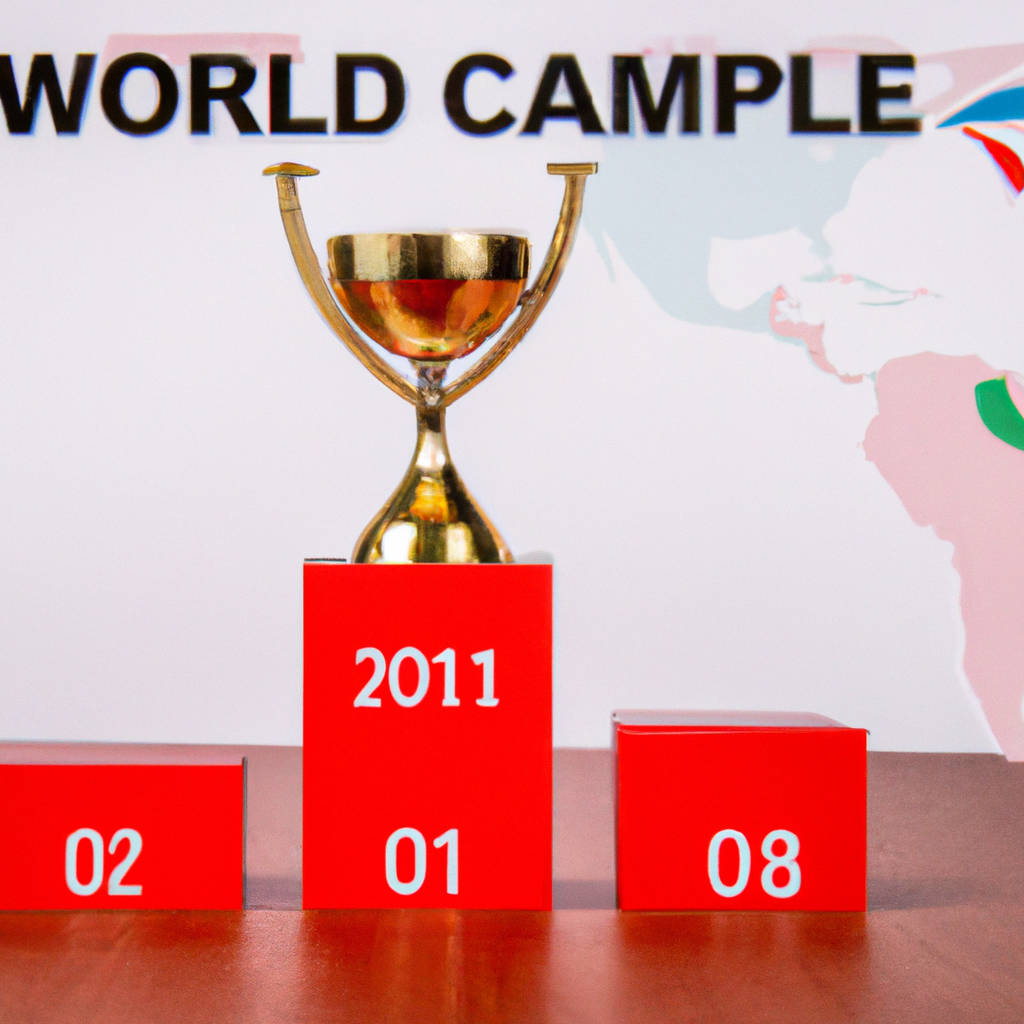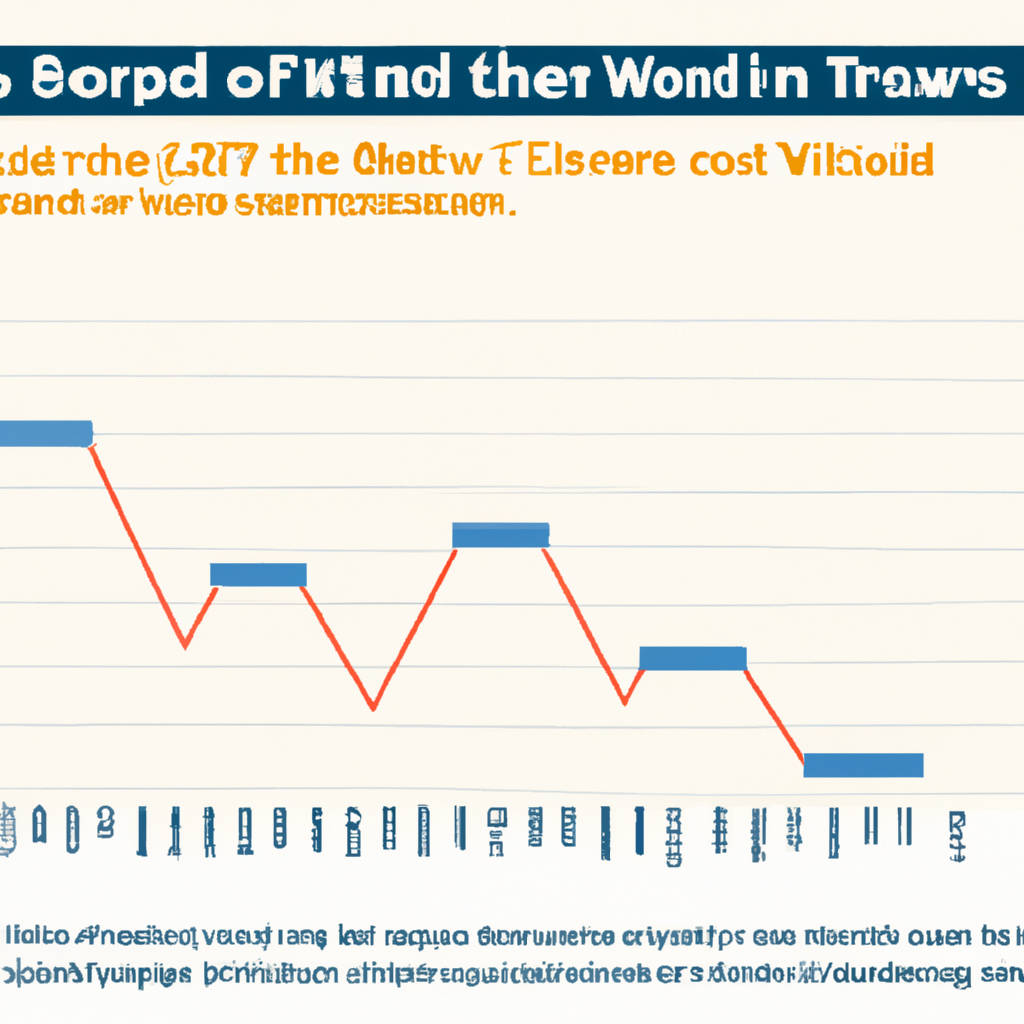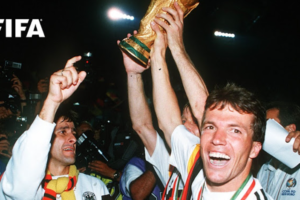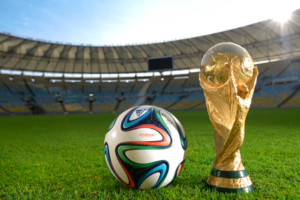The FIFA World Cup is arguably the most prestigious and highly anticipated tournament in international football. As teams from around the globe gather to compete for the coveted trophy, the overview of the standings becomes a crucial aspect of the event. The standings reflect the performance and progress of each participating team, providing fans and experts with valuable insights and creating a sense of excitement and anticipation throughout the tournament.
The standings serve as a yardstick to measure the success and achievements of each team. They showcase the number of matches played, victories, draws, and defeats, as well as the number of goals scored and conceded. This comprehensive overview allows fans to track the progress of their favorite teams and assess their chances of advancing to the knockout stages.
Moreover, the standings play a vital role in determining the teams that will qualify for the knockout rounds. Only the top few teams from each group are granted this opportunity, making each match and point crucial. The standings not only reflect the current state of affairs but also act as a predictor of future outcomes, influencing the strategies and tactics employed by coaches and players alike.
The overview of the standings also fuels the competitive spirit among the teams. As they strive to climb the rankings, teams are motivated to perform at their best, pushing their limits and displaying their skills on the grandest stage. The standings create a healthy sense of competition and encourage fair play, as teams battle it out to secure their place in the later stages of the tournament.
In conclusion, the overview of the FIFA World Cup standings is a crucial aspect of the tournament. It provides fans and experts with valuable insights, acts as a predictor of future outcomes, determines the teams that progress to the knockout stages, and fuels the competitive spirit among the participants. As the tournament unfolds, the standings become a focal point of attention, adding to the drama and excitement that surrounds this global sporting event.

Understanding FIFA World Cup Standings
Understanding FIFA World Cup Standings
The FIFA World Cup is the most prestigious and widely watched sporting event in the world. Every four years, nations from around the globe come together to compete for the coveted trophy. One of the most important aspects of the tournament is the standings, which determine the progress of teams throughout the competition. In this text, we will delve into the intricacies of understanding FIFA World Cup standings.
The standings in the FIFA World Cup are determined by the performance of teams in the group stage, followed by the knockout stage. In the group stage, teams are divided into groups, typically consisting of four teams. Each team plays a round-robin format, where they face every other team in their group once. The outcomes of these matches are then used to determine the standings.
The first criterion used to determine the standings is the number of points earned by each team. A win awards three points, a draw awards one point, and a loss awards no points. This system encourages teams to strive for victories and discourages negative tactics. Points are crucial in determining a team’s position in the standings and can be the difference between progressing to the knockout stage or being eliminated.
If two or more teams have the same number of points, the goal difference comes into play. Goal difference is calculated by subtracting the total number of goals conceded from the total number of goals scored. This criterion emphasizes the importance of both attacking and defensive capabilities. A team that scores more goals than they concede will have a positive goal difference, which could give them an advantage in the standings.
In some cases, even goal difference may not be sufficient to decide the standings, especially when two teams have the same points and goal difference. In such situations, the number of goals scored becomes the next determining factor. This criterion rewards teams that are more prolific in front of goal and showcases their attacking prowess. It adds an element of excitement to the tournament, as every goal scored can potentially impact a team’s standing.
If, after considering points, goal difference, and goals scored, two or more teams are still tied, the head-to-head record between the tied teams is taken into account. This means that the results of the matches played specifically between the tied teams are used to determine their standings. This criterion places emphasis on head-to-head encounters and can provide thrilling storylines when teams face each other with their World Cup fate on the line.
In rare cases, when all the above criteria fail to break the tie, fair play points are considered. Fair play points are awarded based on the discipline of the teams, taking into account the number of yellow and red cards they receive. This criterion promotes sportsmanship and encourages teams to play with fairness and respect. It is a testament to FIFA’s commitment to ensuring that the World Cup is a competition characterized by fair play and good conduct.
Understanding FIFA World Cup standings is crucial for fans and teams alike. It provides a clear picture of a team’s progress throughout the tournament and determines their fate in advancing to the knockout stage. By considering points, goal difference, goals scored, head-to-head record, and fair play points, the standings capture the essence of the competition and showcase the teams’ performances on the grandest stage of international football.
Group Stage Standings
The group stage standings in any competition are always a fascinating aspect to follow, as they provide a clear picture of how teams are performing and progressing in the tournament. Whether it is a sports event like the World Cup or a gaming competition, these standings help us gauge the current state of affairs and make predictions about which teams might advance to the next round.
The group stage is the initial phase of a tournament, where teams are divided into different groups based on various criteria, such as their previous performance, ranking, or even a random draw. Each group consists of a predetermined number of teams, usually four or six, depending on the size of the competition. The teams then face each other in a round-robin format, playing matches against every other team in their group.
These matches are crucial for teams to accumulate points and secure a higher position in the group stage standings. Points are awarded based on the outcome of each match, with a win usually earning three points, a draw earning one point, and a loss yielding no points. Additionally, the goal difference, which is the difference between the number of goals scored and conceded, is also taken into account as a tiebreaker when teams have the same number of points.
The group stage standings can often be unpredictable, as underdogs can surprise stronger teams, and favorites can stumble and drop crucial points. This uncertainty adds an element of excitement to the competition, as fans and spectators eagerly track the progress of their favorite teams.
As the matches progress, the group stage standings start to take shape, with some teams emerging as clear frontrunners while others struggle to find their footing. The standings can reveal interesting patterns and trends, such as teams with a strong offense but a leaky defense, or teams that excel in counter-attacking strategies but struggle against possession-based opponents. These insights can be crucial for coaches and analysts, who can then adjust their tactics and game plans accordingly.
Moreover, the group stage standings also reflect the overall competitiveness of the tournament. A closely contested group, where all teams are neck and neck, can be an indication of the high level of competition and the potential for thrilling matches. On the other hand, a group where one team dominates the others can demonstrate the disparity in talent and skill level among the participants.
For teams, the group stage standings hold immense importance as they determine their fate in the tournament. Securing a top position in the standings often means a more favorable draw in the next round, as the top teams from different groups face the runners-up from other groups. This can potentially provide an easier path to the later stages of the competition, giving teams a better chance of winning the title.
However, a low position in the group stage standings does not necessarily spell doom for teams. Some competitions offer a second chance through a knockout stage play-off, where teams that finish third in their group get an opportunity to compete for a spot in the next round. This provides an additional layer of excitement and keeps the tournament alive for more teams.
In conclusion, the group stage standings play a pivotal role in any competition, providing a snapshot of teams’ performances and determining their fate in the tournament. They showcase the strengths and weaknesses of each team, while also reflecting the overall competitiveness of the event. As fans and spectators, we eagerly follow these standings, analyzing the data and making predictions about which teams will ultimately emerge victorious.
Knockout Stage Standings
The Knockout Stage Standings: A Glimpse into the Battle for Glory
As the group stage of a tournament comes to an end, the anticipation and excitement among fans reach its peak. It is during this crucial phase when the real test of a team’s mettle begins. The Knockout Stage signifies a shift in gears, where each match becomes a do-or-die battle, and the standings hold the key to the dreams and aspirations of every team involved.
The Knockout Stage is a thrilling spectacle that showcases the best teams, their skills, and their determination to secure a place in the finals. It is a stage where the margin for error diminishes, and every decision, every pass, and every shot can have a profound impact on a team’s journey in the tournament.
One of the most intriguing aspects of the Knockout Stage is the standings. The standings provide a snapshot of each team’s performance, their victories, their defeats, and their overall progress in the tournament. It is a reflection of their hard work, preparation, and strategic prowess. The standings not only determine who advances to the next round but also shape the narrative of the tournament.
In this intense battle for glory, teams strive to secure the top spot in the standings. The coveted first position ensures a more favorable draw in the subsequent rounds, giving the team a perceived advantage. However, the difference between the top teams is often marginal, making each match a nail-biting affair. A single goal or a moment of brilliance can tip the scales, reshuffling the standings and altering the course of the tournament.
The Knockout Stage standings also create an atmosphere of competition and urgency. Teams on the brink of elimination fight tooth and nail to climb up the ranks and keep their hopes alive. The pressure mounts as the stakes get higher, and the teams at the bottom of the standings face an uphill battle to turn their fortunes around.
As the tournament progresses, the standings become a source of motivation and inspiration. Teams in the upper echelons draw confidence from their strong performances, knowing that they are just a step away from glory. On the other hand, teams in the lower half of the standings find solace in the fact that they still have a chance to redeem themselves and make a comeback.
The Knockout Stage standings also play a pivotal role in shaping the strategies and tactics employed by the teams. Managers analyze the standings, studying their opponents’ strengths and weaknesses, in order to devise a game plan that maximizes their chances of success. The standings provide valuable insights into the form and style of play of each team, allowing for meticulous preparations and calculated risks.
Moreover, the Knockout Stage standings serve as a testament to the unpredictability and drama of the tournament. Underdogs have emerged from the shadows, defying expectations and stunning the football world by toppling giants. The standings act as a canvas on which these stories of triumph and resilience are painted, reminding us that anything is possible in the beautiful game.
In conclusion, the Knockout Stage standings are the heartbeat of a tournament, encapsulating the essence of competition, passion, and determination. They reflect the progress, struggles, and triumphs of each team, setting the stage for thrilling encounters and unforgettable moments. As fans eagerly follow the standings, they become part of a collective experience, united by their love for the game and the quest for glory.
Historical Trends in FIFA World Cup Standings
Throughout the history of the FIFA World Cup, there have been numerous trends and patterns that have emerged in the standings of the tournament. These trends provide a fascinating insight into the evolution of the competition and the teams that have participated in it. From dominance by certain nations to surprising upsets, the World Cup standings tell a story of triumph and disappointment.
One notable trend in the World Cup standings is the dominance of certain nations. Brazil, for instance, has been the most successful team in the tournament’s history, having won the trophy a record five times. The Brazilian national team has consistently displayed a level of skill and talent that has made them a formidable force on the world stage. Similarly, Germany and Italy have also been successful, with four titles each. These nations have proven their ability to perform under pressure and consistently reach the latter stages of the tournament.
Another trend that has emerged in the World Cup standings is the rise of underdog teams. Throughout the tournament’s history, there have been several instances where relatively unknown teams have made surprising runs and defied expectations. One such example is the United States team in the 1950 World Cup. Considered heavy underdogs, they famously defeated England, a football powerhouse, with a score of 1-0. This victory remains one of the biggest upsets in World Cup history and stands as evidence that anything can happen in the beautiful game.
The World Cup standings also reveal a trend towards more competitive tournaments. In the early years, a few dominant teams would often secure the top spots, leaving little room for surprises. However, as the competition grew and more nations started participating, the level of competition increased significantly. This trend is evident in the fact that over the past few decades, the tournament has seen a wider distribution of winners. Since 1990, six different nations have lifted the trophy, showcasing the growing strength and diversity of teams in international football.
In recent years, there has also been a noticeable trend towards closer matches and lower-scoring games in the World Cup. This shift can be attributed to various factors, such as improved defensive strategies and a greater focus on tactics. The days of high-scoring matches with numerous goals seem to be giving way to tightly contested battles, with teams relying on solid defense and strategic play. This change in dynamics has made the tournament even more thrilling, as every goal becomes crucial and every match can be a potential upset.
One final trend worth noting is the impact of hosting the World Cup on a nation’s performance. Historically, host nations tend to perform better than expected, often benefiting from home support and familiarity with their surroundings. This trend is not universal, but it has been observed in several instances. For example, France won the tournament in 1998 when they hosted it, and Germany finished third in 2006. Hosting the World Cup can provide a significant boost to a team’s morale and motivation, leading to improved performances.
In conclusion, the World Cup standings reveal several historical trends that shed light on the evolution of the tournament. From the dominance of certain nations to the rise of underdogs, the competition has provided numerous memorable moments. The growing competitiveness, closer matches, and the impact of hosting the tournament all contribute to the excitement and unpredictability of the FIFA World Cup. As the tournament continues to evolve, these trends will undoubtedly continue to shape its future.

Highlighting notable records and milestones in FIFA World Cup standings
The FIFA World Cup stands as the pinnacle of international football, capturing the hearts and imaginations of millions across the globe. Over the years, this prestigious tournament has witnessed remarkable records and milestones that have etched their names in the annals of football history. From astonishing goal-scoring feats to unexpected underdog triumphs, the World Cup has been a breeding ground for extraordinary achievements.
One of the most notable records in World Cup history belongs to the legendary Brazilian striker, Ronaldo. In the 2002 tournament held in South Korea and Japan, Ronaldo lit up the stage in spectacular fashion. With an extraordinary display of skill, he scored eight goals, leading his team to a resounding victory. Ronaldo’s performance not only secured Brazil’s fifth World Cup title but also earned him the Golden Boot as the tournament’s top scorer. This remarkable feat cemented his status as one of the greatest footballers of all time.
Another milestone that stands out in World Cup standings is the unprecedented success of the German national team. With a rich footballing tradition, Germany has made its mark on the tournament’s history with impressive consistency. Their most remarkable achievement came in 2014 when they triumphed over Argentina to secure their fourth World Cup title. This victory marked a significant milestone for Germany, as it was their first win as a unified nation since the fall of the Berlin Wall. The German team showcased their tactical brilliance and team cohesion, leaving an indelible mark on the tournament’s history.
Additionally, the World Cup has witnessed the rise of underdog teams, defying all odds to make their mark on the global stage. In 1950, the United States shocked the world with their incredible performance against England, widely regarded as the birthplace of football. Despite being considered heavy underdogs, the American team secured a historic 1-0 victory, causing one of the biggest upsets in World Cup history. This triumph not only boosted the popularity of football in the United States but also showcased the unpredictability and magic of the tournament.
Furthermore, the World Cup has been a platform for extraordinary individual performances. In 1986, Diego Maradona, the Argentinean maestro, delivered a masterclass in football artistry. With his mesmerizing dribbling skills and unmatched vision, Maradona single-handedly led Argentina to victory, culminating in their second World Cup title. His infamous “Hand of God” goal against England and the astonishing solo goal against Belgium remain iconic moments in World Cup folklore.
Beyond individual achievements, the World Cup has also witnessed impressive team performances that have left an indelible mark on the tournament’s history. In 1970, the Brazilian national team, led by the mesmerizing Pele, showcased their unparalleled attacking prowess, scoring a staggering 19 goals in just six matches. Their free-flowing style of play captivated audiences worldwide, earning them their third World Cup title. Brazil’s dominance and flair on the pitch during this tournament set a benchmark for future generations, inspiring countless young players to follow in their footsteps.
The FIFA World Cup is a tournament that embodies the essence of football, and its rich history is adorned with remarkable records and milestones. From Ronaldo’s goal-scoring prowess to Germany’s consistent success, from underdog triumphs to individual brilliance, the World Cup has provided countless unforgettable moments. These records and milestones not only define the tournament’s legacy but also inspire generations of footballers to strive for greatness. The World Cup remains a symbol of unity, passion, and the pursuit of sporting excellence, showcasing the beautiful game at its finest.
Impact of Standings on FIFA World Cup Legacy
The FIFA World Cup is undoubtedly one of the most anticipated and celebrated sporting events in the world. Every four years, nations from around the globe unite to showcase their talent, passion, and love for the beautiful game. While the tournament itself is a spectacle, the impact of the standings on the legacy of the World Cup cannot be overlooked.
The standings, or rankings, play a crucial role in determining the success and legacy of the FIFA World Cup. They provide a reflection of a nation’s footballing prowess, historical achievements, and overall standing in the global football community. The higher a nation’s ranking, the more recognition and prestige it receives in the tournament and beyond.
One of the most significant impacts of the standings on the World Cup legacy is the opportunity it provides for underdog nations to make a mark on the global stage. The standings act as a benchmark for qualification, ensuring that only the best teams from each region get the chance to compete. This creates a fair and competitive environment, where smaller nations can challenge the traditional powerhouses and create memorable upsets. These upsets not only boost the confidence and morale of the underdog team but also inspire generations of young footballers in their home countries.
Furthermore, the standings also have a direct impact on the level of competition in the tournament. Higher-ranked teams are often pitted against lower-ranked teams in the earlier stages, allowing for potentially more exciting and evenly matched games. This adds to the overall excitement and unpredictability of the World Cup, making it a thrilling experience for both players and spectators alike.
In addition to the immediate impact on the tournament itself, the standings also have a lasting legacy on the development of football in each participating nation. A strong performance in the World Cup can serve as a catalyst for the growth of football infrastructure, grassroots development, and increased investment in the sport. The success and recognition garnered from a high standing can attract sponsors, investors, and resources to improve training facilities, coaching programs, and youth academies.
Moreover, a nation’s standing in the World Cup can have a profound impact on the pride and unity of its citizens. The tournament has the power to bring people together, transcending social, cultural, and economic divides. A strong performance by a national team can instill a sense of national pride, fostering a shared identity and a collective celebration of sporting excellence. This, in turn, can have positive social and economic impacts, as it promotes tourism, boosts national morale, and builds a positive international image for the country.
However, it is important to note that the impact of the standings on the World Cup legacy is not solely positive. While a high standing can bring numerous benefits, it can also place immense pressure on the participating teams and their players. The weight of expectations can sometimes hinder performance and create an environment of heightened stress and scrutiny. This can have detrimental effects on the mental and physical well-being of the players, leading to underwhelming performances and a negative legacy for the team.
In conclusion, the impact of the standings on the FIFA World Cup legacy is undeniable. It determines the composition of the tournament, provides opportunities for underdog nations, and influences the level of competition. Additionally, it has a profound impact on the development of football in participating nations, fostering national pride and unity. However, the pressure associated with high standings can also have adverse effects. Ultimately, the standings shape the narrative of each World Cup, leaving a lasting legacy on the tournament and the sport as a whole.

Standings in Popular Culture
Standings in Popular Culture: Navigating the Norms and Trends
Popular culture is an ever-evolving tapestry that weaves together the collective interests, beliefs, and values of society. It serves as a reflection of our shared experiences, shaping our identities, and influencing the way we perceive the world. From music and film to fashion and art, popular culture encompasses a vast array of mediums that captivate and connect individuals across the globe. Within this dynamic landscape, the concept of “standings” emerges, representing the ever-shifting hierarchies and trends that dictate what is deemed socially acceptable or desirable.
In the realm of music, standings can often be observed through the rise and fall of various genres and artists. Consider the emergence of rock ‘n’ roll in the 1950s, which challenged the prevailing musical norms and gave birth to a cultural revolution. Suddenly, Elvis Presley and Chuck Berry became the epitome of cool, attracting legions of fans who passionately embraced this rebellious new sound. These musicians symbolized a departure from the established order, solidifying their standings as cultural icons and challenging the status quo.
Similarly, the world of film provides a rich tapestry of standings that reflect societal values and preferences. Throughout the history of cinema, certain genres have risen to prominence while others have fallen out of favor. From the golden age of Hollywood to the advent of independent filmmaking, cinematic standings have been shaped by factors such as audience demands, technological advancements, and cultural shifts. The transition from classic Hollywood musicals to gritty crime dramas like “The Godfather” exemplifies this evolution, as societal tastes for entertainment transformed alongside societal changes.
Fashion, too, is intricately entwined with standings in popular culture. Styles and trends have the power to convey social status, personal identity, and even political statements. The fashion industry is constantly reinventing itself, with designers and influencers dictating what is considered fashionable at any given time. From flapper dresses in the 1920s to athleisure wear dominating the 2010s, the ever-changing standings in fashion reveal the inherent desire for self-expression and societal approval.
Artistic expressions in popular culture also reflect standings, often challenging conventional norms and pushing boundaries. Street art, for instance, emerged as a powerful form of self-expression that transcends traditional artistic settings. Artists like Banksy have utilized their work to provoke thought, ignite conversations, and challenge societal norms. By defying the confines of traditional galleries, street artists have carved out their own standings in the art world, reaching a broader audience and democratizing the creative process.
Television and streaming platforms have also become significant arenas for standings within popular culture. The rise of reality television, for example, has created a new breed of celebrity, where everyday individuals are thrust into the limelight based on their ability to entertain or shock audiences. The popularity of reality shows such as “Keeping Up with the Kardashians” or “The Bachelor” has not only influenced what we watch but also impacted our perceptions of fame, success, and personal relationships.
In conclusion, standings in popular culture reflect the ever-changing landscape of societal norms, trends, and preferences. Whether it is music, film, fashion, art, or television, these standings shape our collective consciousness and provide a lens through which we view the world. They offer a glimpse into the zeitgeist of a particular era, revealing the desires, aspirations, and passions of a society at any given moment. As we continue to navigate the intricate web of popular culture, it is important to recognize the power and influence of standings and to critically engage with the narratives they create.
Future of FIFA World Cup Standings
The FIFA World Cup has always been the pinnacle of international football, captivating millions of fans around the globe with its thrilling matches and intense competition. As the tournament evolves with each passing edition, it is only natural to ponder what the future holds for the world cup standings and the teams that partake in this prestigious event.
One potential aspect that could shape the future of FIFA World Cup standings is the advancement of technology. With the rapid growth of artificial intelligence and data analytics, teams may be able to gain a competitive edge by utilizing sophisticated algorithms to analyze player performance, team tactics, and match statistics. This could provide valuable insights into how to best approach each opponent, leading to more accurate predictions and potentially influencing the final standings.
Moreover, with the advent of virtual reality and augmented reality technologies, fans could soon experience the World Cup in an entirely new way. Imagine being able to put on a pair of VR goggles and find yourself standing on the pitch alongside your favorite players, witnessing their every move in real-time. This immersive experience could deepen the bond between fans and the teams they support, potentially leading to an increased interest in the World Cup and subsequently influencing its standings.
Another factor that could shape the future of the World Cup standings is the continued globalization of football. Over the years, we have witnessed the sport’s exponential growth in various regions around the world. With more countries investing in youth development programs and infrastructure, the talent pool is expanding, and we can expect to see more nations emerging as strong contenders in the World Cup.
Furthermore, the rising popularity of women’s football could also impact the future standings. The women’s game has seen tremendous growth in recent years, with increased participation, investment, and media coverage. As the sport continues to progress, we can anticipate more nations developing strong women’s national teams, leading to a more competitive and diverse World Cup.
The future of the World Cup standings may also be influenced by changes in the tournament format itself. FIFA has already announced that the 2026 edition will expand to include 48 teams, up from the current 32. This change will provide more opportunities for nations that previously struggled to qualify, potentially leading to a more level playing field and a more unpredictable outcome. Additionally, debates are ongoing regarding the possibility of hosting the World Cup in multiple countries or regions, which could introduce new dynamics and impact the overall standings.
Finally, the future of the World Cup standings may be shaped by the continued efforts to promote fair play and sportsmanship. FIFA has been actively pushing for initiatives such as anti-discrimination campaigns, support for grassroots football, and the fight against match-fixing. These efforts aim to ensure that the World Cup remains a competition based on skill, integrity, and respect, thereby enhancing the credibility and fairness of the standings.







